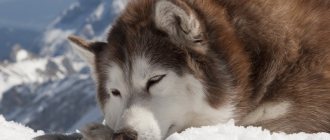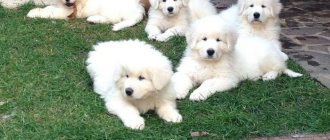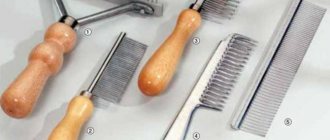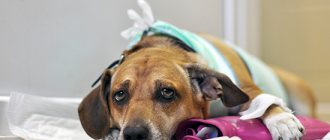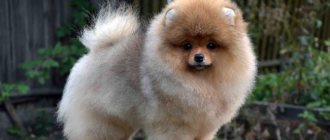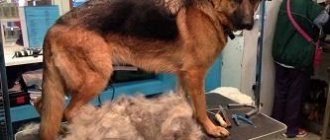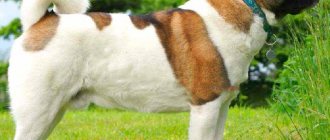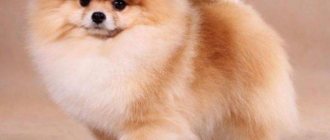Features of wool
The Spitz resembles a small teddy bear with button eyes and a beautiful collar. This effect is achieved due to the abundant soft undercoat and stiffer long hair. Thanks to the dense undercoat, the awn is held perpendicular to the skin, giving a rounded silhouette.
In order for the pet to remain “plush”, it is necessary to carry out grooming - caring for its appearance. Regular procedures include brushing once a week. Frequent brushing can lead to the loss of most of the undercoat, causing the pet to become “smooth” because... The guard hair will fall off, or even develop unsightly bald spots. When combing, more careful attention should be paid to the ears, armpits, and crotch. These places are most susceptible to the formation of tangles.
Grooming your Pomeranian is necessary to give it shape and is done every two to three months. After the procedure, the pet becomes a real beauty with even, smooth, well-groomed fur. You can cut only the ends or make a model haircut that suits a specific pet. Grooming a German or any other Spitz is carried out according to a single algorithm .
Natural causes
Non-hormonal or natural causes of hair loss in dogs include:
- Age-related or seasonal shedding
Age-related shedding can be observed in young dogs, when soft, fluffy, thick hair is replaced by a harder one.
Seasonal molting in animals living in nature occurs twice a year - in spring and late autumn. It is associated with changes in temperature and daylight hours. In winter, dogs grow a thick undercoat that protects them from the cold. By summer, it completely falls out, thereby reducing the risk of heat stroke.
In dogs living in apartment conditions, the process of changing coats does not have clear time limits. The reason for this is a violation of the temperature regime in which the animal is forced to remain. In this case, wool grows all year round, and only in spring and autumn can you notice a more active process of its loss.
- Stress due to moving an animal or changing owner
Stress can have a detrimental effect on your health. The first visible sign of deterioration is dullness and loss of the dog's fur. In order not to aggravate the incipient disease, you need to contact a veterinarian as soon as possible, take the necessary tests and begin treatment.
- Exposure to parasites
Winter walk
The presence of fleas, lice eaters, ticks, subcutaneous parasites and even worms very often causes hair loss in dogs. In addition, the above parasites have a detrimental effect on the animal’s nervous system. Due to constant discomfort and incessant itching, the dog becomes nervous and even aggressive. Her appetite may decrease and lethargy appear.
If nothing is done and the parasites are allowed to grow to critical levels, the death of the animal is inevitable.
- Improper or unbalanced diet
Your dog's diet should contain the vitamins, minerals and trace elements necessary to maintain its healthy physical condition. If there is a deficiency of at least one of them, failures occur that have a detrimental effect on the general condition of the animal.
Thus, a lack of zinc leads to baldness, roughening and subsequent cracking of skin areas on the hock and elbow joints, on the pads of the paws and on the muzzle. With insufficient amounts of fatty acids, skin itching occurs, resulting in irritation, the appearance of crusts, wet ulcers and hair loss in dogs.
- Frequent bathing of the animal using detergents
The dog's skin secretes a protective fatty layer, which is effectively preserved by the hair and protects the skin from drying out and cracking. Overly clean dog owners wash their dogs unreasonably often using shampoos and conditioners. As a result, the fat layer disappears without having time to accumulate, the skin begins to itch, the hair breaks and falls out.
If you continue water treatments, not paying attention to the deterioration of the coat, you can lead the dog to complete baldness, decreased immunity, colds, pneumonia and other unpleasant consequences.
Bathing
Shedding in Spitz dogs
The first molt occurs at 3-4 months. The pet's appearance changes noticeably. During this period, guard hair appears, and the down is replaced by a permanent coat of hair. Until two or three years of age, the volume of fur constantly increases, and by three years the fur coat is fully formed and stops growing and shedding intensively. By this time, you can choose any show hairstyle for your pet.
Adult Spitz dogs shed twice a year, gradually shedding their guard hair and undercoat. Spitz shed quite slowly, because... the undercoat delays the hairs, and there is no need to worry about wool scraps around the house. However, it is necessary to remove dead hairs, so during the shedding period, the Spitz is combed several times a week. A well-groomed, short-haired Spitz practically does not shed.
Shedding
Pomeranians, like other dog breeds, are prone to shedding. The fact is that each hair, having gone through its life cycle, dies, leaving room for new hair. Pomeranians have a long and intense period of hair loss. A dog can shed heavily, losing about half the volume of its coat. There are several types of shedding - seasonal, age-related and hormonal.
Seasonal
Hair begins to fall out under the influence of the hormone melatonin, released in the pituitary gland as a reaction to changing climatic conditions. Such molting occurs in the off-season - in spring and autumn. By the warm season, the orange sheds its warm undercoat, and in the fall it loses its long hairs so that there is more space for a downy coat. If the dog is indoors and rarely goes outside, shedding occurs gradually throughout the year.
Age
At about four months of age, Pomeranian puppies experience their first molt. Baby fluff is replaced by coarse wool, and the color of the pet may change. First, the fluff disappears on the dog’s face, then on the body, and at the very end the collar and panties of the hind legs peel off. At the same time, molting can occur gradually or abruptly.
In the second case, especially with the rapid growth of the animal, the fluff is shed abruptly and the new appearance can shock the owner. The second stage of coat change occurs when the dog is one year old, and can become a smooth continuation of the puppy moult. The undercoat that has already appeared falls off within three months, giving way to coarse hair. The dog takes on the familiar appearance of a classic orange at the age of two.
We suggest you familiarize yourself with: Hair decoctions for growth
Hormonal
The female half of Pomeranians are prone to intense hair loss during estrus. And in the event of childbirth, noticeable bald patches may appear on the dog, or even almost complete baldness may occur. During this period, the pet must be fully fed, ensuring the correct set of vitamins and microelements in the diet.
Hair loss can be caused by hormonal imbalance. You need to pay attention to the following possible problems:
- bald patches near the female genitals may indicate excess estrogen formed in the body;
- a castrated female can rarely boast of a healthy coat; a lack of estrogen makes the hair thin and inhibits its growth;
- severe sudden hair loss can be caused by large amounts of cortisol;
- if the thyroid gland is malfunctioning, the fur becomes brittle and falls out on the chest and back of the animal;
Other reasons
Hair loss without signs of skin inflammation in Spitz dogs is called alopecia X. There is no clear answer to why a dog develops this disease.
When is a haircut necessary?
When starting a breed, owners must be prepared for regular grooming of the Spitz, not only for exhibitions, but also for everyday hygiene. Like the Yorkshire Terrier breed, grooming the Spitz's coat is a necessary procedure, especially before a show.
Haircut prevents:
- formation of tangles;
- felting of wool;
- heavy shedding;
- fracture and loss of the spine.
A thick fur coat is a decoration and protection for the Spitz. It protects the pet from cold and heat.
Dogs do not sweat through their skin, so cutting their hair bald will not save your pet from the heat. On the contrary, exposed skin will become vulnerable to overheating and sunburn. In addition, completely shaved Spitz hair does not grow back. It is recommended to leave at least 3-4 cm.
How to trim a Pomeranian at home
Some owners groom their Pomeranian Spitz themselves, saving on visiting a professional. It is quite possible to trim your pet's hair at home, but you need to know how and what to do. For those new to caring for a Spitz, it is better to go to a salon for the first time, consult with professionals and see how the master handles scissors. It is also better to seek help from a specialist before the exhibition.
Haircut is carried out in three stages:
- combing;
- bathing;
- the actual haircut.
You should be prepared for your pet's resistance. Under no circumstances should you shout or try to force the dog to sit down the way it should. It is better to learn the appropriate command (for example, “swim”, “cut your hair”) and reward for good behavior.
Preparation
Before cutting, it is necessary to comb out the rich coat of the Pomeranian.
To properly comb your pet, you should follow the following rules:
- always comb against hair growth, from tail to head;
- use a soft brush that does not tear hair;
- do not comb too intensively, depriving the dog of the undercoat;
- try not to touch the delicate skin with the tool or use a comb with rounded teeth.
All tangles should be removed. To do this, they are taken apart and plucked out. For easy detangling, it is recommended to use an anti-tangle spray.
It is better to hold babies in your arms while combing while they get used to cosmetic procedures. It is recommended to train adult pets to a specific place for grooming (table, ironing board).
Bathing
After all the tangles have been combed and untangled, begin bathing. It should be remembered that it is recommended to bathe your Spitz when it gets dirty, no more than once a month. After a walk, you only need to wash your paws in the shower. Do not bathe your pet during shedding, because... the wool may become matted. An alternative to wet bathing is dry shampoos, which are applied to the coat and combed out along with the dirt.
For swimming you will need:
- special shampoos and conditioners for dogs with thick undercoat;
- antistatic;
- whitening products (shampoos, powders) for snow-white Spitz dogs;
- towel;
- hairdryer
Bathing is carried out in three stages:
- Preparation;
- water procedures;
- drying.
After the dog has been combed the ears are plugged with cotton to prevent water from getting in, and they are placed in the bathtub. With a gentle pressure of water, completely wet the pet, excluding the head. Using a sponge or your hands, apply shampoo evenly and foam slightly, making sure that the hair does not get tangled. Then rinse off, apply and leave in conditioner, wash the fur, allow the pet to shake off and blot with a towel.
You cannot comb wet wool , because... it is easy to damage the structure of the hairs. After bathing, the pet is thoroughly dried with a hairdryer. Naturally, a Spitz will take a very long time to dry. In addition, poorly dried undercoat provokes irritation and skin diseases.
The dog is dried as follows:
- the hair dryer is adjusted to the desired temperature to make the pet comfortable (not too cold, but not too hot);
- using a flat comb, lightly lift the hair against growth ;
- areas of raised wool are dried.
Do not bring the hair dryer too close to the skin or hold it on one area for a long time. The procedure is easy and quick. After drying, you need to comb your pet to smooth out the clean fur.
Prevention of baldness in Pomeranians
Caring for a Spitz's coat is somewhat more difficult than in the case of other breeds that do not have as much hair. Caring for your fur coat must be thorough. Many owners forget about daily combing, which leads to the formation of tangles.
Puppies need to be brushed with a soft brush, while metal combs are better for adults. You need to pay attention to feeding your pet. The content of microelements and vitamins must be balanced. Dog nutrition includes food specifically designed for furry breeds.
Firstly, do not read or listen to recommendations to wash your dog no more than once every six months. These tips are only suitable for short-haired dogs with no undercoat or dogs that live outside. Your Pomeranian should be washed once a week using a high quality moisturizing shampoo and conditioner. Washing gently removes dead hair, and a good conditioner moisturizes the coat, which has been dried out by apartment air and heating.
Secondly, the wool must be thoroughly combed with a comb, after moistening it with a conditioner diluted 1:10 with water. Spray the coat with the solution from a spray bottle, wait 1 to 3 minutes, and then carefully comb the coat from the roots with a massage comb. The skin massage performed by the comb provides a rush of blood to the follicles, strengthens the hair follicles and helps to change the “baby” coat. Combing is optimal 3 times a week.
Walks.
A Spitz is not a lap dog; you need to take him for walks. Every day. In any weather. Especially in winter, cool weather perfectly stimulates fur growth. Males should be walked especially carefully.
Yes, and one more thing, just in case. The Spitz does not need clothes. Neither warm, nor light, nor beautiful. As a maximum, you can occasionally use a light raincoat for particularly dirty weather. Although normally the coat of a healthy Spitz has dirt-repellent properties.
Feeding.
Everyone, of course, knows that your pet should be fed either high-quality super-premium industrial food or well-balanced natural food. According to the latest metabolic studies in Pomeranian dogs, about 60% of nutrients go to the formation and maintenance of hair! However, many owners stubbornly ignore the recommendations.
Puppies are given sweet, fatty, smoked, salty foods. Every breeder and veterinarian has heard this thousands of times: “it’s just a small piece,” “he loves it so much,” “he doesn’t eat anything else,” or my favorite, “we’ve been feeding our dogs this way all our lives - and nothing.” And the little manipulators are happy, and so the puppy refuses food and demands cheese, sausage, cookies and other contraband.
How not to miss a disease? The first thing that should alert you is dry fur. If the puppy suddenly begins to look like a victim of a half-educated hairdresser - with fur burned through chemicals and paint, urgent measures need to be taken.
Other symptoms of an incipient disease are if a puppy at one year of age has no guard hairs on its back, bald spots appear on its hind legs or tail.
— Polivak-TM vaccine, therapeutic dosage is calculated according to the dog’s weight. The injection is given intramuscularly, twice. For the first time on one leg, 10 days later on the other.
- give an antihistamine (Fenistil/Zyrtec/Suprastin) and treat against ticks and fleas. An antihistamine is necessary because very often, treatment for ticks and fleas causes an allergic reaction.
The most reliable and safe remedy in my experience is Stronghold (sold in veterinary pharmacies, dosage based on the dog’s weight). Bravecto chewable tablets have also worked well. Attention, not both drugs at once, just one, to choose from!
We suggest you read: Hair masks to strengthen the hair follicle
- PDE has proven itself to be excellent - denatured, emulsified placenta (look for it in veterinary pharmacies). It is possible in drinking form, but it is better in injection form. An invigorating cocktail of amino acids, vitamins and microelements. This medication can also be rubbed into the skin. Before rubbing the placenta, you need to carefully prepare the skin; to do this, take a high-quality scrub (look in the cosmetics departments of trusted stores) and after washing, treat your pet with it thoroughly, “until squeaky.” After this, rinse, pat the skin with a towel and rub the placenta.
— it would be a good idea to purchase a meso-roller and “roll” it over the dog every 3-5 days; the dog, of course, may not like it, but the procedure is effective.
In addition to the above, I highly recommend giving your pet vitamins and probiotics. Some of the best are Lactis Zoo, FortiFlora. Vitamins are good in oil, give strictly according to the scheme.
If you did not have time to take action in time and your baby Spitz has gone bald, be patient, treatment will take from 6 to 12 months. You will be able to see the first results in about two months - spots will appear on the dog, then they will begin to peel off and soon fluff will appear.
In the vast majority of cases, strict adherence to all the above recommendations leads to a complete cure - no matter how deplorable your baby Spitz looks, don’t give up, it will almost certainly be possible to fix it.
Alopecia also occurs in adult dogs, most often after a short clipper haircut, I already wrote about this here
What else? Treatment of alopecia is the case when it is worth starting treatment with the gentle regimens described above aimed at restoring immunity and metabolism; in 95% of cases this helps. Most veterinarians strive to first rule out Cushing's disease or thyroid problems. Since they are extremely difficult to diagnose, most often veterinarians act blindly and at random, prescribing one or another difficult-to-tolerate hormone treatment with serious side effects.
Many veterinarians suggest castrating the dog in case of alopecia. The method is not without reason, but only under the condition of a reliably diagnosed hormonal imbalance. Here again - see above, the diagnosis is made at random. I still haven’t met any specialists whose opinion I could trust in this matter. Incorrectly prescribed hormonal treatment can cripple and even kill a dog. Unfortunately, there are many cases.
Another popular misconception is that if the skin darkens, then this is certainly BSD or black skin disease. If the skin is not protected by hair, especially in summer, it tans and becomes pigmented black.
Alopecia X is not covered by the breeder's warranty, as are all other diseases caused by improper maintenance and care.
To summarize: feed properly, take care of the coat and take a walk every day! This will help you avoid Pomeranian alopecia.
Author Elena Gainulina, veterinarian, cynologist expert,
owner of the nursery from Panda Sharm.
If you notice that your dog is becoming very bald, then, first of all, change its diet and review the level of care for your Spitz’s coat. Most often, the reason lies in this. For a month, wash your dog once every 3 days with Nizoral shampoo if you notice fungal diseases due to baldness.
Deworm your pet, and to prevent the drug from causing itching, take antihistamines - all this is done in consultation with your veterinarian. The dog is given additional vitamins and its coat is brushed daily.
It is important to remember that any connivance in this situation is unacceptable. If you notice baldness on your Spitz's body, hips, or tail, immediately take him to the veterinarian and begin a comprehensive examination. Alopecia is treatable, the main thing is to properly care for the dog.
A haircut
Small Spitz puppies are not cut. Until three months, the dog is simply combed, and the condition of the ears is monitored and the claws are trimmed. From 3.5 months (after the first molt) until one year, the ears and paws are shaped.
The fully formed coat of the Pomeranian Spitz is leveled with scissors. People do not use trimmers or clippers. What you might need for a haircut:
- sharp small scissors;
- scissors with blunt ends;
- thinning scissors;
- metal combs with frequent and rare teeth;
- massage brush with long teeth.
How to cut different areas of the body is described below.
Ears. It is necessary to determine the edge of the ear and pinch it between the thumb and forefinger. Protruding hairs are carefully trimmed.
Collar. In the front, the hair is straightened with a comb down, in the back - combed from the neck to the back of the head. The designated boundaries of the “mane” are grabbed with your fingers and aligned in a circle to the desired length. From the chest to the chin, the fur is cut lengthwise to form a semicircle in profile.
Rear end. The tail is raised (an assistant will be needed), the hair around the anus is combed in different directions as it grows, and long hairs are cut off. The edges of the “butt” are grasped with the fingers, and all excess is cut off.
Tail. Comb it up, fluff it up and lay it on your back. Divide into two halves and trim the edges. The tail should look uniform, without protruding hairs, but fluffy and rich.
Paws. Comb the fur hanging from the paws and trim with scissors. For convenience, it is better to bend the paw at the joint. Using blunt-tipped scissors, carefully trim the hair between the toes.
Upon completion of the procedure, they are used with thinning scissors to smooth out unevenness and make the haircut more natural.
Types of haircuts
Rich wool gives room for imagination. You can turn your pet into a fox, a bear, or a lion. Several types of haircuts for Spitz dogs with photos will help you make your choice.
Pod Boo
A fashionable and very beautiful haircut is considered “bear-like” or “boo-like”. Boo is a dwarf Pomeranian who has taken social media by storm with his expressive eyes and plush appearance. Characteristic features of the “Boo” haircut are:
- rounded head (ears at the same level as the mane);
- short hair all over the body;
- uniform length of hair on paws.
The result is a “bear” with soft paws and a “cheeky” head. The haircut is only suitable for dwarf breeds.
Despite its cute appearance, the Spitz will not be able to participate in exhibitions. In addition, the cover will take a very long time to recover.
Light edging
A minimal amount of hair is removed to give a well-groomed, natural look. The ears and edges of the coat are trimmed. For greater effect, you can create maximum edging and trim the dog all over the body, emphasizing the silhouette. The average coat length is maintained.
Model
A professional groomer will help you choose the right haircut for a specific Spitz. A specialist will be able to highlight the advantages and hide the shortcomings of the pet. At the owner’s request, the Spitz will be made into a “husky”, “fox”, or “bear”.
Mad
Brave owners paint their Spitz dogs in different colors (with safe paints), cut their mohawks or shapes, emphasize their cheeks or ears, and accentuate their paws and tail. Without proper experience, it is better to entrust the realization of your imagination to a groomer.
Under the lion
An even more extreme haircut than "Boo". The Spitz is completely shaved to the level of the shoulder blades. The wool remains:
- on the head and neck, forming a mane;
- on the tips of the paws;
- at the tip of the tail.
It should be remembered that after such a haircut the coat will no longer be restored and the Spitz will remain naked. In cold and hot weather, he will need clothing to protect his skin.
Hygienic
Regular, non-show haircuts give your Spitz a well-groomed appearance. Includes several procedures:
- thorough combing;
- the washing up;
- drying;
- treatment of eyes and ears;
- cutting hair between the paws, around the anus, genitals;
- nail trimming.
Exhibition
To make the haircut look natural and neat, your Spitz should be cut six months before the expected exhibition. According to the standard, a Spitz should look like this:
- rounded (cat) paws;
- a lush tail lying on the back reaches the head;
- round collar;
- ears are buried in the mane;
- the combs are even and smooth.
The haircut should hide imperfections from the watchful eyes of judges, so it is better to entrust preparation for the exhibition to professionals.
Home
To make home care and maintenance easier, your Spitz can be cut “at home ,” i.e. relatively short, leaving 3-5 cm in length. The owner can handle this task on his own.
Tips for cutting and grooming
To summarize, we should outline the general sanitary and hygienic rules for caring for the exterior of a Spitz:
- brush once a week, during shedding - 3-4 times a week;
- carefully monitor the condition of the hair behind the ears, in the armpits and perineum, preventing the formation of tangles;
- bathe once a month or when heavily soiled;
- use only dog shampoos and conditioners;
- make sure that soap suds do not get into your eyes and ears;
- trim to create an even shape as the hair grows no more than once every 2-3 months;
- Trimming the fur on the paws and ears is allowed once a month.
A trimmed Pomeranian always looks attractive and well-groomed. This procedure should not be neglected, even if the pet is not preparing for exhibitions. It is better to entrust extreme haircuts to professionals, but you can trim the fur at home.
Did you like the article? Tell your friends, leave a comment)
Alopecia X
If you notice that your dog's hair is falling out, urgently take your Pomeranian to a veterinarian, who will prescribe urine and blood tests. The animal may have problems with the thyroid gland.
But you cannot immediately start giving your dog hormones, no matter how much the doctor insists on it. First, you need to start taking more careful care of the pet’s coat and reviewing your pet’s diet, as well as start restoring its immunity.
In more than half of cases, alopecia stops if the animal is castrated (sterilized). In any case, breeding representatives of a breed prone to baldness is pointless. If a castrated dog continues to go bald, then comprehensive tests are carried out to identify hormonal and allergic diseases (Cushing's syndrome, hypothyroidism) and treatment with hormonal drugs may be prescribed.
Important! If a balding dog is often exposed to the sun, the skin in areas not covered by fur may darken. There is no itching from alopecia, but if the animal itches a lot, this indicates the appearance of a skin fungus.
It is worth understanding that the first results of treatment will appear in 1-2 months, not earlier. Therefore, do not stuff your dog with all types of medications at once, so as not to ruin its liver. Treat carefully, under the supervision of an experienced doctor.
Alopecia X is manifested by total baldness of the Spitz, in which hair remains only on the head and paws. It appears either in six-month-old puppies, which for some reason did not begin to shed on time, or in adult dogs aged 3-4 years. An excessively short haircut of the dog can provoke an incipient disease.
Symptoms
The first symptoms of alopecia X in animals include dry and brittle hair. It feels like the dog made a bad trip to the hairdresser. Later, hair and fluff continue to appear in clumps, and bald spots appear. If such signs appear, you should visit a veterinarian and rule out serious diseases.
Treatment
Treatment of alopecia X is best done after consulting a doctor and conducting the necessary research. Even a simple urine test can clarify the situation. You can start treatment by using antifungal and medicated shampoos, which will prevent your Spitz from developing skin problems if the immune system is weakened.
If hair loss becomes pronounced, you should consult a veterinarian-dermatologist. The following signs indicate developing alopecia X disease:
- at one year of age, timely shedding has not occurred, but puppy fluff is still present;
- the appearance and condition of the coat indicate problems;
- the appearance of itching and bald spots, ulcers and scratching on the skin;
- the eyes turned red, the fur around them thinned;
- In bald spots, the skin darkens.
We suggest you familiarize yourself with: Pharmacy products against hair loss
If your Spitz is going bald, the first thing to do is take urine and blood tests. Based on their results, the dog’s health status will become clear.
